Alan Turing
![]()
Alan Mathison Turing OBE, FRS [ˈælən ˈmæθɪsən ˈtjʊəɹɪŋ] (born 23 June 1912 in London; † 7 June 1954 in Wilmslow, Cheshire) was a British logician, mathematician, cryptanalyst and computer scientist. He is now considered one of the most influential theorists of early computer development and computer science. Turing created a large part of the theoretical foundations for modern information and computer technology. His contributions to theoretical biology also proved to be groundbreaking.
The computability model of the Turing machine he developed forms one of the foundations of theoretical computer science. During the Second World War, he was instrumental in deciphering the German radio messages encrypted with the German rotor cipher machine Enigma. Most of his work remained under lock and key even after the end of the war.
In 1953, Turing developed one of the first chess programs, the calculations of which he did himself due to a lack of hardware. The Turing Award, the most important award in computer science, and the Turing Test for testing the existence of artificial intelligence are named after him.
In March 1952, Turing was sentenced to chemical castration for his homosexuality, which was still prosecuted as a crime at the time. Turing fell ill with depression as a result of the hormone treatment and died by suicide about two years later. In 2009, then British Prime Minister Gordon Brown issued an official apology on behalf of the government for Turing's "appalling treatment" and acknowledged his "extraordinary services" during the war; however, a pardon was still denied in 2011 despite a petition. On Christmas Eve, 24 December 2013, Queen Elizabeth II posthumously issued a Royal Pardon.
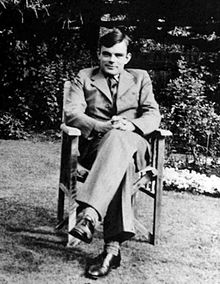
Alan Turing (ca. 1938)
Life and work
Childhood and youth
Alan Turing's father, Julius Mathison Turing, was a British civil servant with the Indian Civil Service. He and his wife Ethel Sara (née Stoney) wished their children to grow up in Britain. Therefore, before Alan's birth, the family returned from Chatrapur, then British India, to London-Paddington, where Alan Turing was born on 23 June 1912. As his father's civil service was not yet over, he travelled again to India in the spring of 1913, where his wife followed him in the autumn. Turing and his elder brother John were taken to St Leonards-on-the-Sea, Hastings, into the care of the family of a retired colonel and his wife. Subsequently the parents shuttled between England and India until Turing's mother decided to stay in England for a long time in 1916 and took the sons back to live with her.
Turing's high aptitude and intelligence were evident from an early age. It is reported that he taught himself to read within three weeks and was attracted to numbers and puzzles at an early age.
At the age of six, Turing was sent to the private day school St Michael's in St Leonards-on-the-Sea, where the headmistress noticed his talent early on. In 1926, at the age of 14, he transferred to Sherborne School in Dorset. His first day at school there coincided with a general strike in England. Turing was so motivated, however, that he covered the 100 kilometres from Southampton to school alone on his bicycle, stopping only once in the night at a public house; at least that is what the local press reported.
Turing's drive for science met with little approval from his teachers at Sherborne; they emphasized the humanities rather than the sciences. Nevertheless, Turing continued to show remarkable ability in the fields he loved. For example, he solved advanced problems for his age without having previously acquired any knowledge of elementary infinitesimal calculus.
In 1928, Turing came across the work of Albert Einstein. He not only understood them, but independently extracted Einstein's law of motion from a text, although it was not explicitly mentioned.
College time and theoretical work
Turing's reluctance to work as hard for the humanities as for the sciences meant that he failed the examinations a number of times. Because this lowered his grade average, he had to go to a second choice college, King's College, Cambridge, in 1931, against his wishes to study at Trinity College. He studied from 1931 to 1934 under Godfrey Harold Hardy (1877-1947), a respected mathematician who held the Sadleirian Chair at Cambridge, which was at the time a centre of mathematical research.
In his work On Computable Numbers, with an Application to the "Decision Problem" (28 May 1936), which was fundamental for this branch of mathematics, Turing reformulated Kurt Gödel's results of 1931. He replaced Gödel's universal, arithmetic-based formal language with a simple mental mechanism, an abstract-formal string-processing mathematical machine known today as the Turing machine. ("Decision problem" refers to one of the 23 most important open problems in 20th century mathematics, presented by David Hilbert in 1900 at the 2nd International Congress of Mathematicians in Paris ["Hilbertian problems"]). Turing proved that such a device is capable of solving "any conceivable mathematical problem, provided that it can also be solved by an algorithm".
Turing machines are to this day one of the focal points of theoretical computer science, namely computability theory. With the help of the Turing machine, Turing succeeded in proving that there is no solution to the "decision problem". He showed that mathematics is in a sense incomplete, because there is in general no way to determine whether any mathematical statement formed syntactically correctly is provable or disprovable. To this end, he proved that the halting problem for Turing machines is not solvable, i.e., that it is not possible to decide algorithmically whether a Turing machine, set to an input (initial tape allocation), will ever come to a halt, that is, terminate the computation. Turing's proof was published only after Alonzo Church's (1903-1995) proof using the lambda calculus; regardless, Turing's work is considerably simpler and intuitively accessible. Also new was the notion of a "Universal (Turing) Machine", a machine that can simulate any other Turing machine. The input to this machine is thus an encoded program interpreted by the universal machine, and the initial value to which it is to be applied.
All computability notions defined up to now (except for the mapping of words to numbers and vice versa) have been shown to be equivalent.
In 1938 and 1939 Turing spent mostly at Princeton University, studying under Alonzo Church. In 1938 he earned a doctorate from Princeton. His doctoral dissertation introduced the notion of "hypercomputation," in which Turing machines were extended to become so-called oracle machines. This made possible the study of nondeterministically solvable problems.
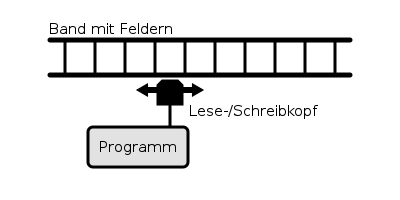
1-band Turing machine: abstract model of a computer that can solve all computable problems with only three operations (read, write and move head)
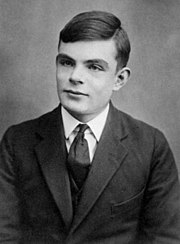
Turing as a 16-year-old
Career and research
After returning to Cambridge in 1939, Turing attended lectures by the Austrian-British philosopher Ludwig Wittgenstein (1889-1951) on the foundations of mathematics. The lectures were reconstructed word for word from the students' notes, including interjections by Turing and other students. The two discussed and argued vehemently: Turing defended mathematical formalism, while Wittgenstein believed that mathematics was overrated and could not reveal absolute truth.
Cryptanalysis
During World War II, Turing was one of the outstanding scientists in the successful attempts at Bletchley Park (B.P. ) to decipher encrypted German radio messages. He contributed some mathematical models to break both the Enigma (see also: Letchworth Enigma) and the Lorenz key machine (see also: Turingery). The insights Turing gained in cryptanalysis of the Fish ciphers later helped in the development of the first digital, programmable electronic vacuum-tube computer, ENIAC. Constructed by Max Newman and his team and built at the Post Office Research Station in Dollis Hill by a team led by Tommy Flowers in 1943, Colossus deciphered the Lorenz machine. Turing also conceived the Bombes named after him. They were successors to the Bomba developed by the Pole Marian Rejewski and were used to determine the keys of Enigma messages. This was an electromechanical device that in principle contained several Enigma machines and was thus able to test and eliminate many possible key settings of the Enigma messages until a possible solution was found (Reductio ad absurdum; German Zurückführung bis zum Widerspruch).
Turing's involvement as one of the key codebreakers in deciphering the Enigma was secret until the 1970s; not even his closest friends knew about it. Deciphering secret German radio messages was a war-deciding component in the Allied victory in the U-boat war and the African campaign.
Work on early computers - The Turing Test
From 1945 to 1948, Turing worked at the National Physical Laboratory in Teddington, where he worked on the design of the ACE (Automatic Computing Engine). The name of the machine is derived from the Analytical Engine of the mathematician Charles Babbage, whose work Turing admired throughout his life.
From 1948 Turing taught at Manchester University and in 1949 became deputy director of the computer department. Here he worked on the software for one of the first real computers, the Manchester Mark I, and at the same time continued various theoretical works. In Computing machinery and intelligence (Mind, October 1950), Turing took up the problem of artificialintelligence and proposed the Turing test as a criterion for determining whether a machine is capable of thinking in a way comparable to humans. Since the thinking process cannot be formalized, the test only considers the responses of a machine in dialogue with a human, i.e. the communicative behavior of the machine. If this appears indistinguishable from human behaviour, it is said to be machine intelligence. He significantly influenced the development of artificial intelligence through the publication.
In 1952 he wrote the chess program Turochamp. Since there were no computers with sufficient power to run it, Turing took over its function and calculated each move himself. This took up to 30 minutes per move. He lost the only game documented in writing against a colleague.
Work on mathematical problems in biology
From 1952 until his death in 1954, Turing worked on mathematical problems in theoretical biology. He published a paper on The Chemical Basis of Morphogenesis in 1952. This paper was the first to describe a mechanism by which reaction-diffusion systems can spontaneously evolve structures. This process, known as the Turing mechanism, is still central to many chemical-biological theories of structure formation. Turing's further interest was in the occurrence of Fibonacci numbers in the structure of plants. Later work remained unpublished until the publication of his collected works in 1992.
Persecution for homosexuality and Turing's death
In 1952, 19-year-old Arnold Murray, with whom Turing had a same-sex relationship, helped an accomplice break into Turing's house. Turing then reported a theft to the police, who, as a result of the investigation, accused him of having a sexual relationship with Murray. As homosexual acts were punishable in England at the time - as in most other countries - Turing was charged with "gross indecency and sexual perversion". Turing saw no reason to defend himself on these charges.
After being sentenced to prison, he was given the choice of serving the prison term or - since homosexuality was considered an illness by much of psychiatry at the time - seeking treatment. He opted for medical treatment, which included drug treatment with the hormone estrogen. This was thought to have a drive-inhibiting effect. The treatment lasted a year and resulted in side effects such as enlargement of the mammary gland. Although he commented on his physical changes with humor, the feminization of his contours must have hit the athletic runner and tennis player hard. Turing fell ill with depression. In the autumn of 1952, Turing began therapy with Franz Greenbaum, a Berlin-born psychoanalyst who had lived in Manchester since 1939. The latter was a follower of C.G. Jung and had been recommended to him by friends as sympathetic to his case. Turing also developed a friendly relationship with the Greenbaum family, whom he also visited privately.
In 1954, Turing died, probably by suicide according to official findings, of cyanide poisoning, apparently from a poisoned apple found half-eaten beside him. Investigators, however, failed to have the apple tested for poison. It is reported that from 1938, after seeing the film "Snow White and the Seven Dwarfs", Turing repeatedly sang the verses Dip the apple in the brew / Let the sleeping death seep through ("Tauch den Apfel tief hinein / bis das Gift wird in ihm sein", in the German version of the film: "Apfel färbt sich strahlend rot / lockt Schneewittchen in den Tod"). The thesis that Turing's death was an accident related to a chemical experiment is strongly contradicted by Andrew Hodges, one of his biographers. There is a widespread assumption among his biographers that the effects of hormone treatment were the main cause of the suicide.
.jpg)
Punched cards for the Automatic Computing Engine of the National Physical Laboratory from 1950
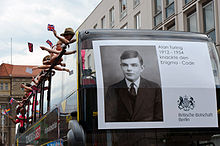
At Berlin's Christopher Street Day 2012, which took place on Turing's 100th birthday, the British Embassy advertised Turing as a codebreaker. Sixty years earlier, state persecution had begun.
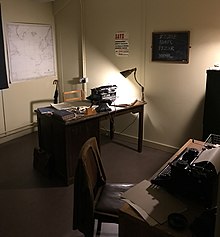
His former study in B.P.
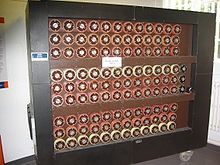
Replica of a Turing bomb
Questions and Answers
Q: Who was Alan Turing?
A: Alan Turing was an English mathematician and computer scientist.
Q: When and where was he born?
A: He was born in Maida Vale, London on June 23, 1912.
Q: Where did he die and on what date?
A: He died in Wilmslow, Cheshire on June 7, 1954.
Q: What are his notable achievements?
A: Turing is best known for his contributions to the development of theoretical computer science and artificial intelligence, as well as for his code-breaking work during World War II.
Q: Did he receive any honors during his lifetime?
A: Yes, he was awarded the Order of the British Empire (OBE) and made a Fellow of the Royal Society (FRS).
Q: How did he contribute to the field of computer science?
A: Turing introduced the concept of a universal machine, which laid the foundation for the development of modern computers. He also developed the idea of algorithms, which are essential to computer programming.
Q: What impact has Alan Turing had on modern society?
A: Turing's work has had a profound impact on the field of computer science and technology, and his contributions continue to influence the development of artificial intelligence and computing systems today. He is also known for his persecution as a gay man, which has sparked discussions and activism around LGBTQ+ rights.
Search within the encyclopedia